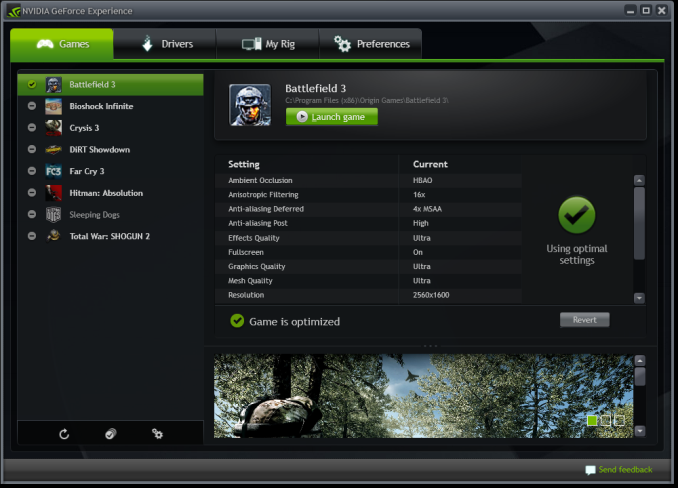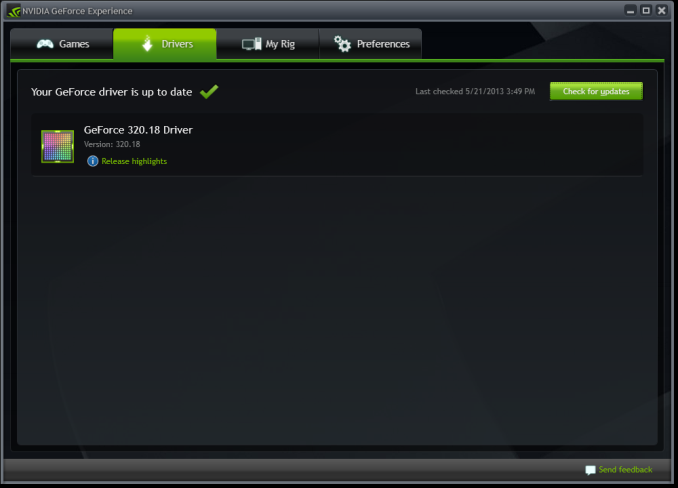NVIDIA GeForce GTX 780 Review: The New High End
by Ryan Smith on May 23, 2013 9:00 AM ESTSoftware: GeForce Experience, Out of Beta
Along with the launch of the GTX 780 hardware, NVIDIA is also using this opportunity to announce and roll out new software. Though they are (and always will be) fundamentally a hardware company, NVIDIA has been finding that software is increasingly important to the sales of their products. As a result the company has taken on several software initiatives over the years, both on the consumer side and the business side. To that end the products launching today are essentially a spearhead as part of a larger NVIDIA software ecosystem.
The first item on the list is GeForce Experience, NVIDIA’s game settings advisor. You may remember GeForce Experience from the launch of the GTX 690, which is when GeForce Experience was first announced. The actual rollout of GeForce Experience was slower than NVIDIA projected, having gone from an announcement to a final release in just over a year. Never the less, there is a light at the end of the tunnel and with version 1.5, GeForce Experience is finally out of beta and is being qualified as release quality.
So what is GeForce Experience? GFE is in a nutshell NVIDIA’s game settings advisor. The concept itself is not new, as games have auto-detected hardware and tried to set appropriate settings, and even NVIDIA has toyed with the concept before with their Optimal Playable Settings (OPS) service. The difference between those implementations and GFE comes down to who’s doing the work of figuring this out, and how much work is being done.
With OPS NVIDIA was essentially writing out recommended settings by hand based on human play testing. That process is of course slow, making it hard to cover a wide range of hardware and to get settings out for new games in a timely manner. Meanwhile with auto-detection built-in to games the quality of the recommendations is not a particular issue, but most games based their automatic settings around a list of profiles, which means most built-in auto-detection routines were fouled up by newer hardware. Simply put, it doesn’t do NVIDIA any good if a graphical showcase game like Crysis 3 selects the lowest quality settings because it doesn’t know what a GTX 780 is.
NVIDIA’s solution of choice is to take on most of this work themselves, and then move virtually all of it to automation. From a business perspective this makes great sense for NVIDIA as they already have the critical component for such a service, the hardware. NVIDIA already operates large GPU farms in order to test drivers, a process that isn’t all that different from what they would need to do to automate the search for optimal settings. Rather than regression testing and looking for errors, NVIDIA’s GPU farms can iterate through various settings on various GPUs in order to find the best combination of settings that can reach a playable level of performance.
By iterating through the massive matrix of settings most games offer, NVIDIA’s GPU farms can do most of the work required. What’s left for humans is writing test cases for new games, something again necessary for driver/regression testing, and then identifying which settings are more desirable from a quality perspective so that those can be weighted and scored in the benchmarking process. This means that it’s not entirely a human-free experience, but having a handful of engineers writing test cases and assigning weights is a much more productive use of time than having humans test everything by hand like it was for OPS.
Moving on, all of this feeds into NVIDIA’s GFE backend service, which in turn feeds the frontend in the form of the GFE client. The GFE client has a number of features (which we’ll get into in a moment), but for the purposes of GFE its primary role is to find games on a user’s computer, pull optimal settings from NVIDIA, and then apply those settings as necessary. All of this is done through a relatively straightforward UI, which lists the detected games, the games’ current settings, and NVIDIA’s suggested settings.
The big question of course is whether GFE’s settings are any good, and in short the answer is yes. NVIDIA’s settings are overall reasonable, and more often than not have closely matched the settings we use for benchmarking. I’ve noticed that they do have a preference for FXAA and other pseudo-AA modes over real AA modes like MSAA, but at this point that’s probably a losing battle on my part given the performance hit of MSAA.
For casual users NVIDIA is expecting this to be a one-stop solution. Casual users will let GFE go with whatever it thinks are the best settings, and as long as NVIDIA has done their profiling right users will get the best mix of quality at an appropriate framerate. For power users on the other hand the expectation isn’t necessarily that those users will stick with GFE’s recommended settings, but rather GFE will provide a solid baseline to work from. Rather than diving into a new game blindly, power users can start with GFE’s recommended settings and then turn things down if the performance isn’t quite high enough, or adjust some settings for others if they favor a different tradeoff in quality. On a personal note this exactly matches what I’ve been using GFE for since the earlier betas landed in our hands, so it seems like NVIDIA is on the mark when it comes to power users.
With all of that said, GeForce Experience isn’t going to be a stand-alone game optimization product but rather the start of a larger software suite for consumers. GeForce Experience has already absorbed the NVIDIA Update functionality that previously existed as a small optional install in NVIDIA’s drivers. It’s from here that NVIDIA is going to be building further software products for GeForce users.
The first of these expansions will be for SHIELD, NVIDIA’s handheld game console launching next month. One of SHIELD’s major features is the ability to stream PC games to the console, which in turn requires a utility running on the host PC to provide the SHIELD interface, control mapping, and of course video encoding and streaming. Rather than roll that out as a separate utility, that functionality will be built into future versions of GeForce Experience.
To that end, with the next release of drivers for the GTX 780 GeForce Experience will be bundled with NVIDIA’s drivers, similar to how NVIDIA Update is today. Like NVIDIA Update it will be an optional-but-default item, so users can opt out of it, but if the adoption is anything like NVIDIA Update then the expectation is that most users will end up installing GFE.
It would be remiss of us to not point out the potential for bloat here, but we’ll have to see how this plays out. In terms of file size GeForce Experience is rather tiny at 11MB (versus 169MB for the 320.14 driver package), so after installer overhead is accounted for it should add very little to the size of the GeForce driver package. Similarly it doesn’t seem to have any real appetite for system resources, but this is the wildcard since it’s subject to change as NVIDIA adds more functionality to the client.


















155 Comments
View All Comments
Rodrigo - Thursday, May 23, 2013 - link
Excellent choice for less money than Titan! :-)Ja5087 - Thursday, May 23, 2013 - link
"NVIDIA will be pricing the GTX 680 at $650, $350 below the GTX Titan and GTX 690, and around $200-$250 more than the GTX 680."I think you mean the 780?
Ja5087 - Thursday, May 23, 2013 - link
Accidently replied instead of commentedRyan Smith - Thursday, May 23, 2013 - link
Thanks. Fixed.nunomoreira10 - Thursday, May 23, 2013 - link
compared to titan it sure is a better value, but compared to the hight end 2 years ago its twice as much ( titan vs 580 ; 780 vs 570 ; 680 vs 560)NVIDIA is slowly geting people acoustmed to hight prices again,
im gona wait for AMD to see what she can bring to the table
Hrel - Friday, May 24, 2013 - link
She? AMD is a she now?SevenWhite7 - Monday, July 8, 2013 - link
Yeah, 'cause AMD's more bang-for-the-buck.Basically, NVidia's 'he' 'cause it's always the most powerful, but also costs the most.
AMD's 'she' 'cause it's always more efficient and reasonable.
I'm a guy, and guys are usually more about power and girls are more about the overall package.
Just my experience, anyway, and this is just me being dumb trying to explain it with analogies =P
sperkowsky - Wednesday, February 26, 2014 - link
bang for your buck has changed a bit just sold my 7950 added 80 bucks and bought a evga acx 780 b stockcknobman - Thursday, May 23, 2013 - link
At $650 I am just not seeing it. In fact I dont even see this card putting any pressure on AMD to do something.I'd rather save $200+ and get a 7970GE. If Nvidia really wants to be aggressive they need to sell this for ~$550.
chizow - Thursday, May 23, 2013 - link
Nvidia has the GTX 770 next week to match up against the 7970GE in that price bracket, the 780 is clearly meant to continue on the massive premiums for GK110 flagship ASIC started by Titan. While it may not justify the difference in price relative to 7970GHz it's performance, like Titan, is clearly in a different class.